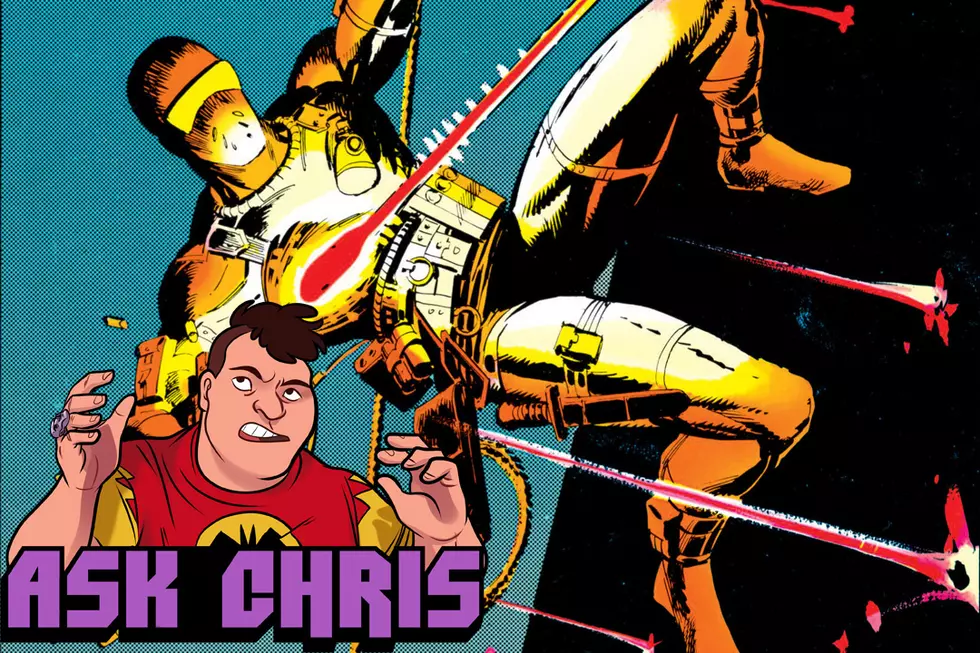
GI Joe’s ‘Death Of Snake Eyes’ Is Quite Possibly The Year’s Weirdest Story, And It’s Great
The thing about GI Joe is that it's weird. I mean, it's always been weird, for the simple fact that you can't really do a comic about a bunch of action figures fighting a megalomaniacal used car salesman bent on world domination without it getting at least a little bizarre, and the Joes, as a franchise, have never really done anything by half measures. That's actually the thing that I like most about the franchise, in that it has this grounding in realistic military action that manifests itself in a world that's about as far from realism as you get, a world full of ninjas, cyborgs, cyborg ninjas and all the other stuff that makes those toys so great.
So believe me when I say that what series creator Larry Hama and artist SL Gallant have been doing in the latest arc is completely off-the-charts bonkers, even by GI Joe standards --- and that's exactly why it's one of the most fun and rewarding comics on the stands.
The latest arc was billed on the covers as The Death of Snake Eyes, and in any other comic, I'd have to imagine that killing off the most popular character in the book would be the biggest thing that happened in the arc. Here, well, it's still a big deal, but everything around it so ridiculously huge that it almost feels like an afterthought.
A lot of that comes from the way that the book's structured. One of the best things about IDW's GI Joe: A Real American Hero is that it picked up exactly where Hama left off when the book ended in 1994 --- and that's not just a matter of numbering. If you read them all in one shot, like I did a few months ago, that 20-year gap between #155 and #156 doesn't feel like much of a gap at all. There's a pretty dramatic change in art style, sure, but other than that, the story and characters keep on moving without a hiccup.
As a result, GI Joe has the feel of a book from 20 years ago, in a really interesting way. It's built on long-term plotting that pays off in the form of issue-to-issue twists and turns rather than more defined arcs. It makes sense that it would, too --- Hama wrote almost every issue of that original run, and we've just passed the five-year mark of this version of the series. That kind of space means that there's a lot of room to let things build and breathe, and probably explains why a good chunk of those past five years has been taken up with a long-running story about cyberninjas that, in a book with more modern pacing, might not have lasted quite as long. Not that I'm the kind of person that complains about having too many cyberninjas in his comics, you understand.
What's really interesting about this is that I read an interview with Hama from a few years ago where he said that when he was working on GI Joe, he was only plotting ahead by "two or three pages at most." If that's the case, then Hama is unquestionably one of the most gifted writers in comics history, if for no other reason than his ability to make connections that pay off years of storytelling and make it look like he knew where it was going all along.
Which brings us back to The Death of Snake Eyes. Or, to be more accurate, what brings us back to that last issue of GI Joe from 1994.
Don't worry, it'll all tie together in a second.
If you're not familiar with it, that last issue is called "A Letter From Snake Eyes," and involves Sean Collins --- the son of a Crimson Guardsman who served with Snake Eyes, Stalker and Storm Shadow in Vietnam --- writing the legendarily silent ninja for advice on whether he should join the army. Despite the fact that Snake Eyes sure does get extremely chatty in his response, it's a very well-written issue that presents the question in a way that's a lot more balanced than you might expect from a book about army soldiers with the words "A Real American Hero" in the title.
When Hama and Agustin Padilla picked up the series, Sean Collins returned as well. It turns out that after reading the letter, he did in fact join the army, and as the series progresses, he's in the background, training with the Arashikage ninjas and eventually getting assigned to the GI Joe team under the codename "Throwdown."
Now here's where it gets weird. Y'all know about the Pit, right? GI Joe's top-secret headquarters, the underground military base in the Utah desert? Okay, good.
But do y'all know about the secret Pit that's underneath the Pit?
Yes: It turns out that the Pit was built in order to hide an even more secret base that was even more underground, which is amazing. But that reveal was, of course, followed by the question of just what could be so secret that it would require two layers of secret bases and constant but unknowing protection by America's Daring, Highly Trained Special Missions Force. And again, after that interview, it's one of those things where you have to wonder if even Hama himself knew where he was going to end up going with it.
Because what's in the Secret Pit... is a giant eyeball from outer space.
Brace yourself, because it's going to get weirder. It turns out that there's an alien intelligence under there, and the original GI Joe and Jane --- whose previous project was a deus ex machina space laser that could vaporize a tank whenever the Joes needed it to --- have built a machine that will allow a human mind to interface with it under their control. And the mind that they choose is, of course, Serpentor, the Cobra Emperor made from the DNA of History's Greatest Conquerors.
You can probably guess how this is going to go wrong, but the part that might still come as a surprise comes from the other half of the story. It's Throwdown's first mission, and it involves those cyberninjas and their biggest project yet: A giant kaiju-sized mech that is bent on destroying GI Joe.
So obviously, the solution to this is to send GI Joe's giant mech, controlled by Serpentor and aliens and also Roadblock in there somewhere, to fight it. That part goes okay, but then you've got Serpentor simultaneously controlling a giant robot in the MIddle East and running rampant in the Pit, where he has suddenly gained the ability to telepathically control all machinery.
At this point, the story is split into two parts, with Throwdown and his unit dealing with the giant robot, and Snake Eyes, Scarlett and Stalker trying to take down Serpentor. The threads start to come together, though, when Serpentor recalls the mech and sends it flying back to Utah at Mach 6, with Throwdown taken along for the ride and suffering horrible burns, and superheated air scarring his vocal cords along the way.
In a last-ditch effort to take out Serpentor, Snake Eyes rushes him with a grenade in each hand, blowing him up (presumably fatally) just as the disabled mech comes crashing down and Throwdown --- scarred, mute, Arashikage-trained Throwdown --- comes out of the mech, picks up Snake Eyes' mask, and puts it on.
So yeah: In The Death of Snake Eyes, Part Two of Four, there is already a new Snake Eyes. It's amazing and delightful, and in two issues, they make it official in one of the most enjoyably bizarre ways possible: They just have a dead guy's friends vote on whether this new guy can become the new version of their dead friend:
It's worth noting that in another continuity, Sean became Kamakura, an apprentice to Snake Eyes, but in this story, Hama and Gallant go all out with it. It is full-on bonkers, it's a story with giant robots and alien eyeballs and cyberninjas, but it's also a payoff over twenty years in the making that feels like this beautiful combination of long-term plotting and Hama just making it up on the spot when he got there in the script. That's what makes it so fun --- that weirdness and unpredictability that feels like a throwback in a way that can still surprise you.
More From ComicsAlliance
![The Dreadnoks Are Back At It Again In ‘GI Joe’ #3 [Preview]](http://townsquare.media/site/622/files/2017/03/GIJoe00.jpg?w=980&q=75)




![IDW Reveals ‘Revolution’ Titles For March, Including ‘Revolution: Aw Yeah!’ [Solicitations]](http://townsquare.media/site/622/files/2016/12/Rev00.jpg?w=980&q=75)
![Ninjak Embarks On A Silent Interlude In ‘Ninjak’ #22 [Preview]](http://townsquare.media/site/622/files/2016/12/Ninjak00.jpg?w=980&q=75)

![The Crown Jewel Of The Hasbro Universe: Aubrey Sitterson On Rebuilding ‘GI Joe’ After ‘Revolution’ [Interview]](http://townsquare.media/site/622/files/2016/09/Joe00.jpg?w=980&q=75)
